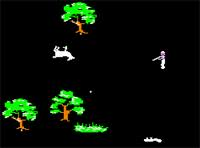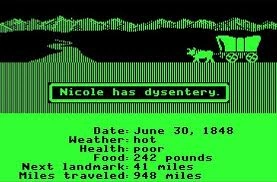(Oregon Trail) |
(Adding categories) |
||
| Line 133: | Line 133: | ||
Images2.jpg|Another character has dysentery. |
Images2.jpg|Another character has dysentery. |
||
</gallery></sup> |
</gallery></sup> |
||
| + | [[Category:Games]] |
||
Revision as of 06:14, 4 July 2013

Hunting
The Oregon Trail is a computer game originally developed by Don Rawitsch, Bill Heinemann, and Paul Dillenberger in 1971 and produced by MECC in 1974. The original game was designed to teach school children about the realities of 19th century pioneer life on the Oregon Trail. The player assumes the role of a wagon leader guiding his party of settlers from Independence, Missouri, to Oregon's Willamette Valley over the Oregon Trail via a Conestoga wagon in 1848. The game has been released in many editions since the original release by various developers and publishers who have acquired rights to the game.
Contents |
[edit] History
The Oregon Trail was created in 1971 by three student teachers at Carleton College in Northfield, Minnesota,[1] in the HP Time-Shared BASIC environment running on an HP-2100 minicomputer.[2] One of these students, senior Don Rawitsch, had the idea to create a computer program for a history class he was teaching, and recruited two of his friends, Paul Dillenberger and Bill Heinemann, both of whom were students teaching math, to help.[3]
The Oregon Trail debuted to Rawitsch's class on 3 December 1971. Despite bugs, the game was immediately popular, and he made it available to others on Minneapolis Public Schools' time-sharing service. When the next semester ended, however, Rawitsch deleted the program, although he printed out a copy of the source code.[3]
[edit] MECC
In 1974 Rawitsch took a job at Minnesota Educational Computing Consortium, or MECC, a state-funded organization that developed educational software for the classroom. He added many historically accurate features and uploaded The Oregon Trail into the organization's time-sharing network, where it could be accessed by schools across Minnesota. The game became one of the network's most popular programs, with thousands of players monthly.[3]
In 1978 MECC began encouraging its schools to adopt the Apple II microcomputer.[3] The first published version of The Oregon Trail was in Creative Computing's May-June 1978 issue. It was written in BASIC 3.1 for the CDC Cyber 70/73-26. The program was then adapted by John Cook for the Apple II, and provided on A.P.P.L.E.'s PDS Disk series #108. A further version called Oregon Trail 2 was adapted in June, 1978 by J.P. O'Malley. The game was further released as part of MECC's Elementary series, on Elementary Volume 6 in 1980. The game was titled simply Oregon, and featured minimal graphics. It proved so popular that it was re-released as a standalone game, with substantially improved graphics, in 1985. By 1995 The Oregon Trail comprised about one third of MECC's $30 million in annual revenue.[4]
An updated version, Oregon Trail Deluxe, was released for DOS in 1992,[5] followed by Oregon Trail II in 1995,[3] The Oregon Trail 3rd Edition in 1997,[6] and 4th[7] and 5th editions.[8] As of 2011[update], more than 65 million copies of The Oregon Trail have been sold.[3]
[edit] Editions
- 1981 to 1985 The Oregon Trail (Apple II)
- 1992 The Oregon Trail Deluxe (MS-DOS)
- 1993-96 The Oregon Trail Ver 1.2 (Windows)
- 1996 The Oregon Trail II (Windows)
- 1997 The Oregon Trail 3rd Edition (Windows)
- 2001 The Oregon Trail 4th Edition (Windows)
- The Oregon Trail 5th Edition (Windows)
- The Oregon Trail: Mobile Edition (iPhone/iPod Touch)
- The Oregon Trail for Facebook[9]
[edit] Gameplay
[edit] Hunting
An important aspect of the game was the ability to hunt. Using guns and bullets purchased over the course of the game, players select the hunt option and hunt wild animals to add to their food reserves. In the original version, there were no graphics and players were timed on how fast they could type "BANG," "WHAM," or "POW," with misspelled words resulting in a failed hunt. Later, players would control a little man who was capable of pointing a rifle in eight directions and firing single shots at animals. In later versions, players hunted with a crosshair controlled by the mouse. Bison were the slowest moving targets and yielded the most food, while rabbits and squirrels were fast and offered very small amounts of food. Deer (eastern section) and elk (western section) were in the middle in terms of speed, size, and food yield; bear were between bison and deer in all three properties. While the amount of wild game shot during a hunting excursion is limited by only the player's supply of bullets, the maximum amount that can be carried back to the wagon is 100 pounds in early versions of the game. In later versions, as long as there were at least two living members of the wagon party, 200 pounds could be carried back to the wagon. It was extremely common for players to kill several thousand pounds worth of animals, only to waste the large majority of it. Some would consider this a realistic representation of the wild west. Also in the later version, you could hunt in different environments. For example, hunting during winter would result in graphics showing grass covered in snow.
[edit] Death
Throughout the course of the game, members of your party could fall ill and die from a variety of causes, such as measles, snakebite, dysentery, typhoid, cholera, and exhaustion. People could also die from drowning or a broken leg. Your oxen were also subject to illness and death. When one of your party members dies, a funeral is briefly held, at which you may write a suitable tombstone epitaph, and after which you continue down the trail.
[edit] Scoring
At the conclusion of the journey, points are awarded according to a formula weighted by the profession chosen (points are doubled for a carpenter and tripled for a farmer), the number and health of surviving family members, remaining possessions, and cash on hand.
[edit] Legacy
[1][2]Map screen from the IBM version
The game was popular among North American elementary school students in the mid 1980s to early 1990s. Many students in the United States and Canada had access to the game at school. MECC followed up on the success of The Oregon Trail with similar titles such as The Yukon Trail and The Amazon Trail.[1] The original title has been re-released many times, for different platforms and on different media; it is currently up to the fifth edition.
The phrase "You have died of dysentery" has been popularized on T-shirts[3] and internet swag.
In 2007, Thule corporation created Thule Trail as a promotional tool. It changed the starting location to Chicago, Illinois, the destination to the "Atlantis Music Festival" in Santa Barbara, California, wildlife to snacks, and made other modern adjustments. In 2008, the band Fall Out Boy released a similarly altered version of the game, "Fall Out Boy Trail," to promote the release of the Folie à Deux.
The game resurfaced in 2008 when Gameloft created an updated version for cell phones.[10][11][3] The rights for this version were later bought up by SpeedDate.com, which replaced the game with an online dating application.[12] A new release for the iPhone and iPod Touch is also available from Gameloft.[13] The game went live in the iTunes App Store on March 11, 2009.[14] On January 7, 2010, the Palm WebOS version was released to the Palm App Catalog. On November 11, 2010, an Xbox Live version was released on Windows Phone 7.
The cell phone version of the game is similar to the original, but varies in that the player can choose one of three different wagons: A basic wagon, a prairie schooner or a Conestoga Wagon. The player can also choose to become a Banker, a Carpenter, or a Farmer, each of which has unique benefits. Unlike the computer version of the game, players in the iPhone and iPod Touch version do not have to purchase guns and bullets.
A DSiWare version of this game was released in North America on December 28, 2009.
A new version of Oregon Trail has been released on the social networking site Facebook on February 2, 2011.[
==See also==
==Gallery==



